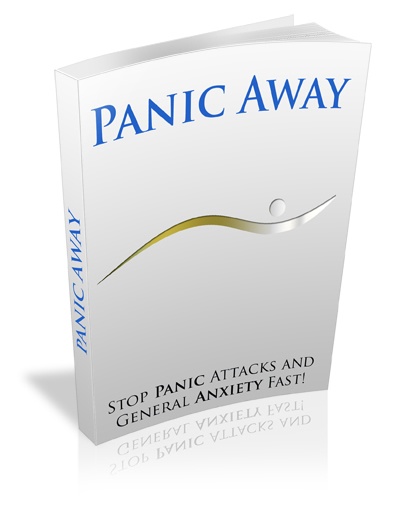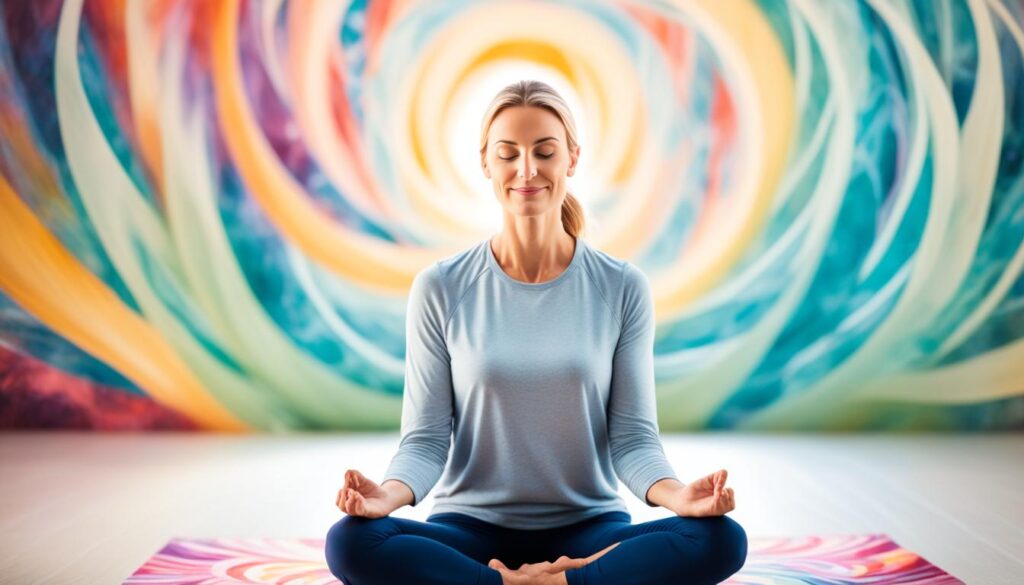As someone who has personally struggled with anxiety, I know all too well the feeling of being trapped in a constant state of worry and unease. The sleepless nights, the racing thoughts, the physical symptoms that seem to tighten their grip on your body. It can feel overwhelming, suffocating even.
But I also know that there is hope. I have discovered the incredible power of mindfulness in my journey towards managing my anxiety. Mindfulness has become my sanctuary, a refuge from the chaos of my own mind.
Our Top Pick For Beating Panic Attacks

Stopping, and preventing, panic attacks is now even easier.
Through mindfulness exercises, I have been able to find moments of peace, to quiet the noise within, and to cultivate a sense of calm that I never thought possible. It has been transformative, and I believe it can be for you too.
So, if you're ready to embark on a journey of self-discovery and find relief from anxiety through mindfulness, I invite you to explore these 5 transformative exercises. They have the power to change your relationship with anxiety and open up a world of peace and tranquility.
Key Takeaways:
- Mindfulness exercises can help anxiety sufferers find relief and cultivate a sense of calm.
- Practicing mindfulness regularly can reduce anxiety triggers and promote mental well-being.
- There are various mindfulness techniques that focus on the mind-body connection and non-reactivity to thoughts.
- Noting and pausing are powerful mindfulness practices that can interrupt the cycle of anxiety.
- Mindfulness can be integrated into everyday life to promote resilience and reduce stress.
The Power of Mindful Breathing
Mindful breathing is a fundamental mindfulness practice that can help anchor our awareness in the present moment. By focusing our attention on the breath, we can reduce the tendency to ruminate on past or future concerns, which are common triggers for anxiety.
This exercise involves observing the breath as it enters and leaves the body, noticing any sensations that arise, and using the breath as a tool to connect with the present moment. By practicing mindful breathing regularly, anxiety sufferers can cultivate a sense of peace and calm in their daily lives.
Benefits of Mindful Breathing
Mindful breathing offers numerous benefits for anxiety relief and stress management. By focusing on our breath, we can:
- Bring our attention to the present moment, reducing rumination and worry.
- Activate the body's relaxation response, soothing the nervous system.
- Increase self-awareness and develop a deeper understanding of our emotional state.
- Improve concentration and focus, enhancing cognitive function.
- Cultivate a sense of calm and inner peace.
How to Practice Mindful Breathing
Follow these steps to practice mindful breathing:
- Find a comfortable seated position, close your eyes or soften your gaze.
- Direct your attention to your breath, noticing the sensation of the breath entering and leaving your body.
- Observe any thoughts, emotions, or physical sensations that arise without judgment, and gently redirect your focus back to the breath.
- Continue this practice for a few minutes or as long as feels comfortable for you.
“Breathing in, I calm my body. Breathing out, I smile. Dwelling in the present moment, I know this is a wonderful moment.” – Thich Nhat Hanh
Regular practice of mindful breathing can gradually reduce anxiety and promote a greater sense of well-being. Try incorporating mindful breathing into your daily routine to experience the transformative power it has on your mental health.
The Mind-Body Connection
Anxiety is not only a mental experience but also a physical one. The mind and body are deeply interconnected, and our emotions can manifest as physical sensations in the body. Mindfulness allows us to tune into this mind-body connection and gain a greater understanding of how anxiety affects us holistically.
By bringing awareness to the physical sensations that arise during moments of anxiety, we can start to identify patterns and triggers that contribute to our mental distress. This self-awareness is a powerful tool in interrupting the cycle of anxiety and taking proactive steps towards anxiety reduction.
One of the mindfulness practices that can help cultivate this mind-body connection is the body scan. This exercise involves bringing attention to different parts of the body, progressively releasing tension and observing physical sensations without judgment or reaction. This practice enhances our ability to recognize and respond to bodily signs of anxiety, such as muscle tension or chest tightness, before they escalate.
| Mind-Body Connection | Benefits |
|---|---|
| Body scan meditation | – Heightens body awareness – Identifies physical signs of anxiety – Encourages relaxation and stress reduction |
| Yoga and mindful movement | – Combines physical activity with mindfulness – Relieves tension in the body – Enhances flexibility and posture |
| Mindful eating | – Develops a healthy relationship with food – Encourages mindful consumption and portion control – Fosters a deeper appreciation for the eating experience |
The Benefits of the Mind-Body Connection
The mind-body connection is a two-way street. Just as anxiety can manifest as physical sensations, engaging with the body can have a positive impact on our mental well-being. By incorporating mindfulness practices that focus on the mind-body connection, anxiety sufferers can experience the following benefits:
- Reduced anxiety symptoms by addressing both the mind and body
- Enhanced self-awareness and recognition of personal triggers
- Greater ability to manage stress and calm the nervous system
- Improved physical well-being, such as reduced muscle tension and improved sleep
“The mind and body are not separate entities; they are intimately connected. By deeply understanding this connection, we can empower ourselves to manage anxiety effectively.”

The mind-body connection is a powerful tool in managing anxiety and promoting overall mental health. By embracing mindfulness practices that foster this connection, anxiety sufferers can develop a deeper understanding of themselves and cultivate a sense of calm and well-being.
Observing Thoughts with Non-Reactivity
When it comes to coping with anxiety through mindfulness, one powerful practice is the ability to observe our thoughts without getting caught up in their content or reacting to them. Anxiety is often fueled by negative thought patterns and projections about the future. By developing non-reactivity towards our thoughts, we can reduce the power they have over us and cultivate a calmer, more balanced mind.
To cultivate non-reactivity towards our thoughts, mindfulness exercises play a crucial role. These exercises help anxiety sufferers observe their thoughts without judgment or attachment. By recognizing thoughts as mere mental events and not as absolute truth, we can create distance and reduce the emotional intensity that often accompanies anxiety.
I find great solace in the practice of observing thoughts without reactivity. It's like creating a safe space within my mind where anxiety loses its grip. – Sarah
One effective mindfulness exercise for cultivating non-reactivity towards thoughts is the “Thought Observation Meditation.” During this practice, you sit in a quiet and comfortable setting, allowing thoughts to arise without engaging with them. Instead of getting tangled in the content of the thoughts, you observe them as if they were passing clouds in the sky – fleeting and temporary.
Another useful technique is the “5-4-3-2-1 Grounding Exercise.” In this exercise, you actively redirect your attention to the present moment by engaging your senses. You take notice of five things you can see, four things you can touch, three things you can hear, two things you can smell, and one thing you can taste. This exercise helps shift your focus away from anxious thoughts and towards your immediate surroundings.
Comparing Mindfulness Practices for Observing Thoughts with Non-Reactivity
| Exercise | Description | Benefits |
|---|---|---|
| Thought Observation Meditation | Observe thoughts without judgment or attachment, like passing clouds. | – Cultivates non-reactivity towards thoughts – Enhances awareness of transient nature of thoughts |
| 5-4-3-2-1 Grounding Exercise | Engage senses to redirect attention to the present moment. | – Shifts focus away from anxious thoughts – Promotes grounding and present-moment awareness |
By practicing these mindfulness exercises, anxiety sufferers can learn to observe thoughts without reactivity and foster a more peaceful and balanced state of mind. Remember, thoughts are not facts, and by developing non-reactivity, we can loosen the grip of anxiety and create space for calmness and clarity.
https://www.youtube.com/watch?v=6iR2Yw8gBIo
The Practice of Noting
Noting is a powerful mindfulness technique that can help anxiety sufferers cope with their symptoms through mindfulness practices. This technique involves observing and labeling our thoughts and emotions without getting caught up in their content. By noting our experiences as they arise, we can develop a greater sense of awareness and gain distance from our thoughts and emotions.
When practicing noting, it's important to cultivate a non-judgmental and curious attitude towards our internal experiences. We observe our thoughts and emotions without clinging to them or trying to push them away. Instead, we acknowledge their presence and label them with a simple word or phrase, such as “thinking,” “feeling,” or “planning.”
Example:
“As I sit in meditation, I notice a thought arise about an upcoming meeting. Instead of getting caught up in that thought and the associated anxiety, I gently note it as ‘planning' and redirect my attention back to my breath.”
By practicing noting regularly, we can develop a greater awareness of our thought patterns and emotional states. This increased awareness allows us to recognize when anxiety arises and respond to it with mindfulness and self-compassion. Noting helps us create space between ourselves and our anxious thoughts, providing a sense of liberation and perspective.
The practice of noting can be integrated into various mindfulness exercises, such as mindful breathing, body scans, or walking meditations. It can also be used in daily life as a way to anchor ourselves in the present moment and manage anxiety as it arises.
Examples of Noting
| Experience | Noting Label |
|---|---|
| A worrisome thought | Thinking |
| A sensation of tightness in the chest | Feeling |
| A mental image of a stressful situation | Imagining |
By using noting as a tool in our mindfulness practice, we can cultivate a greater sense of ease and resilience in the face of anxiety. The act of observing and labeling our experiences helps us develop a non-reactive stance towards our thoughts and emotions, ultimately reducing their power over us. Embracing the practice of noting can be a transformative step in coping with anxiety through mindfulness.

The Power of Pausing
Pausing is a simple yet powerful mindfulness practice that allows us to interrupt the cycle of anxiety and respond to it in a calmer, healthier way. By noticing the gap between the onset of anxiety and our reactive response, we can create space for more mindful and intentional actions.
When we pause, we give ourselves the opportunity to observe our thoughts and emotions without immediately reacting to them. This pause can be as short as a few seconds or as long as a few minutes, depending on the situation. It allows us to gain perspective and question the validity of our anxious thoughts, bringing us back to the present moment.
The next time you feel anxiety creeping in, try pausing for a moment. Take a deep breath and bring your attention to the sensations in your body. Notice any tension or discomfort and allow yourself to fully experience it without judgment. This simple act of pausing can help to de-escalate your anxiety and bring you a sense of calm.
During this pause, you can also engage in mindfulness exercises that specifically target stress management and anxiety relief. Here are a few simple yet effective practices you can try:
- Mindful Breathing: Close your eyes and focus on your breath as it enters and leaves your body. Notice the sensation of the breath, the rise and fall of your chest, and the feeling of air passing through your nostrils.
- Body Scan: Starting from the top of your head, slowly bring your attention to each part of your body, noticing any tension or sensations. Allow yourself to relax and release any physical tension you may be holding.
- Grounding Exercises: Engage your senses by noticing the details of your surroundings. Focus on the colors, textures, and sounds around you, grounding yourself in the present moment.
Practicing these mindfulness exercises during a pause can help you shift your focus away from anxiety-inducing thoughts and bring you a sense of calm and clarity. It allows you to respond to stressful situations with intention and choose healthier coping mechanisms.
Comparison of Mindfulness Exercises for Stress and Anxiety
| Exercise | Description | Benefits |
|---|---|---|
| Mindful Breathing | Focus on the breath as it enters and leaves the body | Calms the mind, reduces anxiety, promotes relaxation |
| Body Scan | Bring attention to each part of the body, observing sensations | Relieves physical tension, promotes body awareness |
| Grounding Exercises | Engage the senses to connect with the present moment | Reduces anxiety, promotes mindfulness, increases self-awareness |
Remember, the power of pausing lies in creating that moment of stillness amidst the chaos of anxiety. Give yourself permission to pause, take a breath, and cultivate a sense of calm through these mindfulness exercises.
Mindfulness Activities for Groups and Group Therapy
Group therapy that incorporates mindfulness has shown promising results in reducing anxiety symptoms. Engaging in mindfulness activities as a group can provide a supportive and nurturing environment for anxiety sufferers to explore their experiences and develop coping mechanisms. Here are some mindfulness exercises that can be done in a group setting:
The Body Scan
The body scan is a powerful mindfulness practice that involves systematically bringing attention to different parts of the body. It helps individuals cultivate awareness of bodily sensations, release tension, and promote relaxation. In a group setting, a facilitator can guide participants through the body scan exercise, allowing everyone to connect with their bodies and find a sense of grounding and calmness.
Mindful Eating
Mindful eating is a practice that encourages individuals to eat with full awareness and non-judgment. In a group setting, participants can engage in a shared mindful eating experience, where they savor each bite, pay attention to the taste, texture, and sensations of the food, and reflect on the connection between eating and nourishing their bodies. This exercise not only fosters a sense of mindfulness but also promotes mindful self-care and appreciation for food.
Walking Meditation
Walking meditation is a form of mindfulness practice that involves bringing awareness to each step and the sensations experienced while walking. In a group therapy session, participants can engage in a guided walking meditation together, focusing on the movement of their bodies, the feeling of their feet connecting with the ground, and the rhythm of their breath. Walking meditation can be especially helpful for anxiety sufferers as it combines the benefits of physical activity with the calming effects of mindfulness.
Mindful Listening
Mindful listening is a practice that cultivates deep awareness and presence while engaging in conversations or listening to others. In a group setting, participants can pair up and take turns practicing mindful listening. One person speaks while the other actively listens, fully present and attentive to the speaker's words, tone, and emotions. This exercise encourages empathy, connection, and compassionate communication among group members.
| Mindfulness Activities for Groups | Benefits |
|---|---|
| The Body Scan | – Cultivates body awareness – Promotes relaxation and stress reduction – Connects individuals to their physical sensations |
| Mindful Eating | – Encourages mindful self-care – Fosters appreciation for food – Enhances the sensory experience of eating |
| Walking Meditation | – Combines physical activity with mindfulness – Promotes grounding and present-moment awareness – Calms the mind and reduces anxiety |
| Mindful Listening | – Enhances communication skills – Cultivates empathy and connection – Supports a compassionate group environment |
Engaging in mindfulness activities as a group can create a sense of shared experience, support, and connection among anxiety sufferers. It offers an opportunity for individuals to learn from each other, gain insights, and develop effective strategies for managing anxiety. By incorporating mindfulness into group therapy sessions, anxiety reduction exercises can be empowering and transformative for the entire group.

Mindfulness Practices for Everyday Life
Mindfulness is not just something we practice during designated meditation sessions; it can be integrated into our everyday lives. By incorporating mindfulness into our daily routines, we can effectively manage stress and anxiety, and cultivate a greater sense of presence, calm, and resilience. In this section, I will discuss several mindfulness practices that anxiety sufferers can incorporate into their day-to-day activities.
Mindful Breathing During Daily Activities
One simple way to infuse mindfulness into our daily lives is by practicing mindful breathing during everyday activities. Whether it's washing dishes, brushing our teeth, or commuting to work, we can bring our awareness to the sensation of the breath. Take slow, deep breaths and notice the inhale and exhale with each activity. This helps to anchor the mind in the present moment, reducing stress and promoting a sense of calm.
Mindful Eating
Eating mindfully is another powerful practice that can help reduce stress and anxiety. Rather than rushing through meals, take the time to savor each bite, noticing the flavors, textures, and smells. Eat slowly and pay attention to the sensations in the body as you nourish yourself. This practice not only enhances the enjoyment of food but also promotes a greater connection to the present moment and fosters a healthier relationship with eating.
Mindful Walking
Walking mindfully is a wonderful way to incorporate mindfulness into our daily routines. Whether it's a short stroll in the park or walking from one room to another, pay attention to the sensation of each step, the contact of your feet with the ground, and the movement of your body. Engage your senses and notice the sights, sounds, and smells around you. Walking mindfully helps to anchor your attention in the present moment, promoting a sense of calm and relaxation.
Mindful Movement
In addition to daily activities, we can also infuse mindfulness into our exercise or movement routines. Whether it's yoga, stretching, or any form of physical activity, bring awareness to the sensations in your body, notice the breath, and remain present with each movement. By practicing mindful movement, we can foster a deeper connection between the mind and body, release tension, and cultivate a sense of inner calm.

By incorporating these mindfulness practices into our everyday lives, we can effectively manage stress, reduce anxiety, and cultivate a greater sense of well-being. The key is to bring awareness and presence to our daily activities, fostering a deeper connection with ourselves and the world around us.
Conclusion
Mindfulness exercises for anxiety sufferers offer powerful tools to cultivate peace, manage stress, and develop a healthier relationship with thoughts and emotions. By incorporating mindfulness into daily life, individuals experiencing anxiety can find relief and build resilience.
Through practices like mindful breathing, observing thoughts with non-reactivity, noting, and pausing, anxiety sufferers can reduce the impact of negative thought patterns and break free from the cycle of anxiety. By embracing the power of mindfulness, individuals can find calm and balance amidst the challenges of anxiety.
Start practicing these mindfulness exercises today and experience the transformative effect they can have on anxiety relief and stress management. By grounding yourself in the present moment, embracing self-compassion, and developing a mindful approach to daily activities, you can reclaim peace and well-being in your life. Remember, mindfulness is a journey, so be patient with yourself as you cultivate these practices and discover the profound benefits they can bring.
FAQ
Can mindfulness exercises really help with anxiety?
Yes, mindfulness exercises have been proven to be effective in alleviating anxiety. By cultivating awareness and practicing mindfulness, anxiety sufferers can reduce stress, manage their anxiety symptoms, and foster a sense of peace and calm in daily life.
What is mindful breathing and how can it help with anxiety?
Mindful breathing is a fundamental mindfulness practice that involves focusing our attention on the breath. By observing the breath as it enters and leaves the body, anxiety sufferers can anchor their awareness in the present moment and reduce the tendency to ruminate on past or future concerns, which are common triggers for anxiety.
How can mindfulness help with the mind-body connection and managing anxiety?
Mindfulness can help anxiety sufferers tune into the mind-body connection and interrupt the cycle of anxiety. By bringing awareness to physical sensations and observing how they relate to emotions and thoughts, individuals can develop a deeper understanding of their anxiety and work towards reducing its impact.
How can mindfulness exercises help anxiety sufferers develop non-reactivity towards their thoughts?
Mindfulness exercises can help anxiety sufferers develop non-reactivity towards their thoughts by recognizing thoughts as mere mental events and not as absolute truth. By observing thoughts without getting caught up in their content or reacting to them, individuals can reduce the power thoughts have over them and cultivate a calmer, more balanced mind.
What is the practice of noting and how can it help with anxiety?
Noting is a mindfulness technique that involves observing and labeling thoughts and emotions without getting caught up in their content. By noting experiences as they arise, anxiety sufferers can develop a greater sense of awareness and gain distance from their thoughts and emotions, helping to manage anxiety more effectively.
How can pausing help anxiety sufferers manage their anxiety?
Pausing is a simple mindfulness practice that allows anxiety sufferers to interrupt the cycle of anxiety and respond to it in a calmer, healthier way. By noticing the gap between the onset of anxiety and our reactive response, individuals can create space for more mindful and intentional actions, gaining perspective and de-escalating their anxiety.
Are there mindfulness activities that can be done in a group setting to manage anxiety?
Yes, group therapy that incorporates mindfulness has shown promising results in reducing anxiety symptoms. Activities such as the body scan, mindful eating, walking meditation, and mindful listening can provide support, connection, and a sense of shared experience for anxiety sufferers in a group setting.
Can mindfulness be integrated into everyday life to manage anxiety?
Absolutely. Mindfulness can be incorporated into daily routines, such as practicing mindful breathing during daily activities, engaging in mindful eating, mindful walking, and mindful movement. By cultivating mindfulness throughout the day, anxiety sufferers can develop a greater sense of presence, calm, and resilience.
Are mindfulness exercises truly transformative for anxiety sufferers?
Yes, mindfulness exercises can be transformative for anxiety sufferers, offering a way to cultivate peace, manage stress, and develop a healthier relationship with thoughts and emotions. By incorporating mindfulness into daily life, anxiety sufferers can find relief and build resilience in the face of anxiety.


